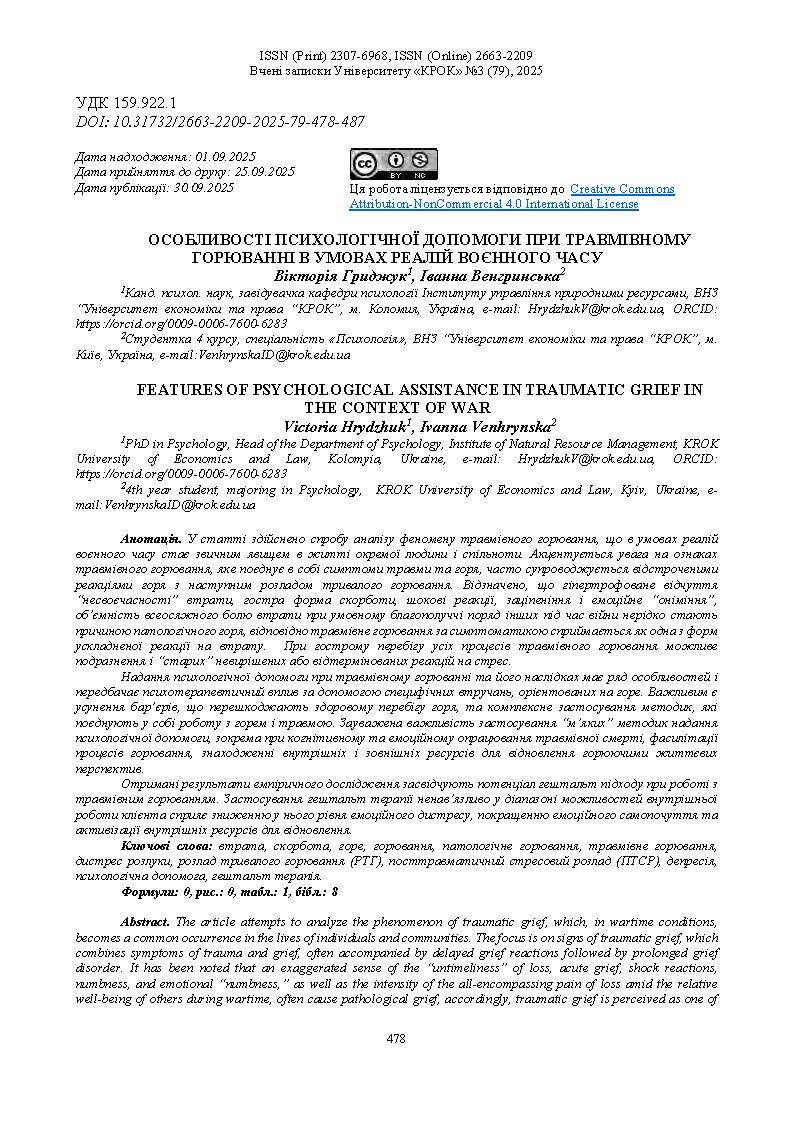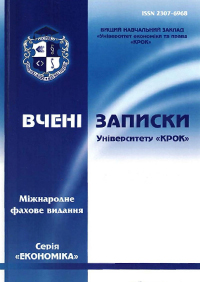FEATURES OF PSYCHOLOGICAL ASSISTANCE IN TRAUMATIC GRIEF IN THE CONTEXT OF WAR
DOI:
https://doi.org/10.31732/2663-2209-2025-79-478-487Keywords:
Gestalt therapy, grief, sorrow, bereavement, pathological grief, traumatic grief, separation distress, prolonged grief disorder (GRD), post-traumatic stress disorder (PTSD), depression, psychological help, , Gestalt therapyAbstract
The article attempts to analyze the phenomenon of traumatic grief, which, in wartime conditions, becomes a common occurrence in the lives of individuals and communities. The focus is on signs of traumatic grief, which combines symptoms of trauma and grief, often accompanied by delayed grief reactions followed by prolonged grief disorder. It has been noted that an exaggerated sense of the “untimeliness” of loss, acute grief, shock reactions, numbness, and emotional “numbness,” as well as the intensity of the all-encompassing pain of loss amid the relative well-being of others during wartime, often cause pathological grief, accordingly, traumatic grief is perceived as one of the forms of a complicated reaction to loss. In acute cases of traumatic grief, it is possible that “old” unresolved or delayed reactions to stress may be triggered.
Providing psychological assistance for traumatic grief and its consequences has a number of specific features and involves psychotherapeutic intervention using specific grief-oriented techniques. It is important to remove barriers that hinder the healthy grieving process and to comprehensively apply techniques that combine grief and trauma work. The importance of using “soft” methods of psychological assistance was noted, particularly in the cognitive and emotional processing of traumatic death, facilitating the grieving process, and finding internal and external resources to restore the bereaved's outlook on life.
The results of the empirical study demonstrate the potential of the Gestalt approach in working with traumatic grief. The unobtrusive application of Gestalt therapy within the range of the client's internal capabilities helps to reduce their level of emotional distress, improve their emotional well-being, and activate internal resources for recovery.
Downloads
References
Аврамчук, О. (2019). Огляд психологічної допомоги при ускладненому горюванні, базованої на когнітивно-поведінковій терапії. Психологічний журнал, Т. 5, 8, 9-24. DOI: https://doi.org/10.31108/1.2019.5.8.1.
Булен, П. & Кольчінська, Ю. (2022). Розлад тривалого горя: природа, чинники ризику, діагностика і когнітивно-поведінкова терапія. Психосоматична медицина та загальна практика, Т. 7, 2. DOI: 10.26766/pmgp.v7i2.375.
Войтович, М. (2018). Психологічна допомога під час горювання. Основи реабілітаційної психології: подолання наслідків кризи. Навчальний посібник. Т. 2. Київ, 77-96.
Рибик, Л. (2023). Теорія горя: сторічна історія розвитку. Проблеми екстремальної та кризової психології, 2(6), 191-206. Retrieved from: http://dcpp.nuczu.edu.ua/images/2023-2/2023_2_2_16.pdf.
Сингаївська І., & Берестовська А. (2024). Особливості надання психологічної допомоги жінкам, які переживають втрату близької людини під час війни. Вчені записки Університету «КРОК», 1(73), 214-226.
- DOI https://doi.org/10.31732/2663-2209-2024-73-214-226.
Neimeyer, R. (2021). Терапія горя (переклад та адаптація В. Зливков, С. Лукомська). Київ. 259 с.
Stroebe, M., Schut, H. & Stroebe W. (2025). Attachment in Coping with Bereavement: A Theoretical Integration. Review of General Psychology, 9(1), 48-66.
Worden, J. (2009). Grief Counseling and Grief Therapy: A Handbook for the Mental Health Practitioner. New York, Springer, 91-106.

Downloads
Published
How to Cite
Issue
Section
License

This work is licensed under a Creative Commons Attribution-NonCommercial 4.0 International License.

